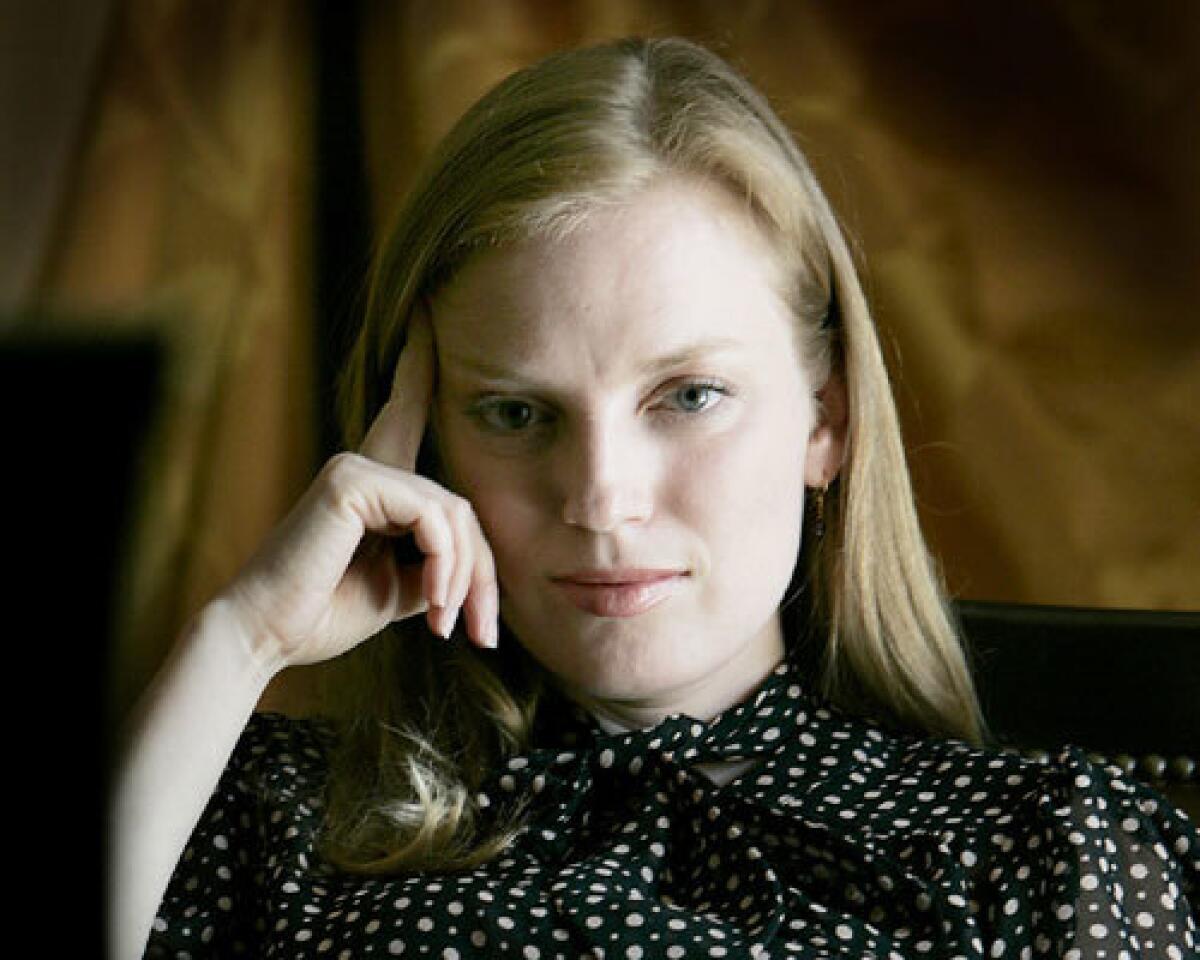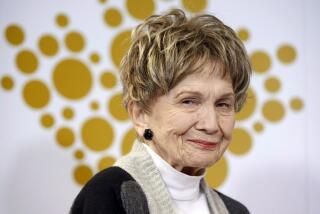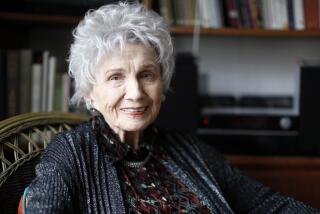‘Away From Her,’ written on the pages of the mind

THE tale of a superhero, a ‘70s drug dealer, or a plot to destroy the world it’s not.
Alice Munro’s “The Bear Came Over the Mountain,” which isn’t really about a bear and does not feature a mountain, is the story of an elderly couple — a once-rakish professor of Nordic literature and his free-spirited, bohemian wife, who is slowly losing her mind.
Most of its low-key plot takes place amid the Ontario snow and inside an unglamorous retirement home. Some of the sharpest revelations come from lost opportunities and things never quite said.
This is not, in other words, the kind of “property” that makes a natural movie.
In fact, one of the people who never imagined it on the screen is the author herself.
“I don’t think my stories lend themselves particularly well,” Munro, who lives in a small town in southwest Ontario and rarely grants interviews, said by phone this week. “I’m not that keen on literature into film. It’s very difficult to translate things.”
But the actress Sarah Polley saw things otherwise. The result is “Away From Her,” which Polley wrote and directed.
“It seemed so obviously cinematic to me,” said Polley, who first read the story in the New Yorker magazine while flying back to Toronto from a film shoot. “The characters were so finely nuanced, the dialogue was so strong, and visually it had such strong imagery,” she said over lunch in Hollywood. “In fact it was one of the rare cases where I thought it was important that the film stay faithful to the original source material.”
The issue of putting a potentially difficult film across to an audience didn’t much concern her. “I didn’t think too much about audience at any point in making the film,” said Polley, a major star in her native Canada and probably best known in this country for her performances in Atom Egoyan’s “The Sweet Hereafter” and Doug Liman’s “Go.” “And I feel that most of my favorite films don’t get made thinking about an audience.” She’s talking, for instance about Ingmar Bergman’s “Scenes From a Marriage,” which she calls her favorite film for its ability to capture “the rawness of what it means for two people to know each other so well.”
“For me the whole idea of adapting this story I loved so much was the idea of finding a way to express the impact it had on me — my experience alone and in solitude,” said Polley, a shy but engaging 28-year-old in a herringbone jacket and jeans who lights up at mention of her favorite writers or Toronto bands. “What was important was that the film had an integrity and had a rhythm and purpose the way the story did without being manipulative.”
An uncluttered quality
To say that the Chekhovian Munro, 75, is acclaimed by the literary world would be an understatement. “Most recently,” Margaret Atwood writes in the introduction to a recent Everyman’s Library collection, “she’s been used as a stick to flog the enemy with, in various inter-writerly combats. ‘You call this writing?’ the flogger says, in effect. ‘Alice Munro! Now that’s writing!’ ”Polley, who has been reading Munro since high school, is so in thrall to her work that she was originally daunted by the idea of adapting it. She admires the distillation, the “deceptively simple,” uncluttered quality of Munro’s work — and the way her stories seem to pierce reality to see beneath surfaces.
“She’s got the keenest eye for the smallest little modulations of human behavior,” the director said. “It makes you see the world more carefully. I think her books have made me a more observant person.”
Polley, who also admires Michael Ondaatje, Penelope Fitzgerald, Don DeLillo and W.H. Auden — whose poetry makes a cameo of sorts in the film — said reading has been “a refuge” for her since she was little.
When it came to adding visual details and even extra scenes to this story about Grant and his wife, Fiona, who has early-onset Alzheimer’s, Polley tried to stay in the story’s spirit. “In the same way I feel that Alice Munro never drifts into the sentimental; in fact she can be almost cruel.”
The film, she said, “was this opportunity to walk around for a few years inside a story I absolutely loved and ask questions about these characters and be curious about them over and over.” The story’s few hints of landscape — “The swamp-oaks and maples threw their shadows like bars across the bright now,” goes one — become the film’s visual palette.
“It was an interior story,” Polley said, “but it was inspired by a very strong visual metaphor, with snow and Canada in the winter.”
Some scenes originated with Polley. One involves a bored teenager visiting the retirement home, whom we see but don’t hear from in the story. In another, a character brutally confronts Grant about his early years as a philanderer. Since much of Munro’s story takes place in Grant’s head, and conscience, Polley needed to put the accusation in another character’s voice so it would register on screen.
Also in Munro’s spirit, Polley said, was leaving out the early meet-cute scenes that would likely have dominated a studio film: “Relying on the device of long, literal flashbacks to show what they were like when they were young was beside the point.” And, she added: “Factually showing something isn’t all that interesting. What’s interesting is how it gets remembered.”
She was glad to have a chance to show an older couple she could take on their own terms. “It’s just not something we get to do in film very much — look at a relationship and see what happens after 44 years. We’re always concentrating on the beginning.”
The biggest departure from the film is taking Munro’s more-or-less straightforward storytelling and shifting it around chronologically. Part of this was simply to make an unlikely encounter between Grant and Marian, the wife of Grant’s romantic rival, resonate properly.
“I also liked the idea of the structure of the film mirroring the fragmentation of memory and us needing to make these connections.”
Polley admits it became, both in the script and in the editing room, “a bit of a puzzle” but that it was one of the most important steps for giving the film dramatic drive. “I guess growing up in Atom Egoyan films really helped. My original sense of film is that it’s nonlinear. That process of one thing not following another is sort of in my blood.”
‘You have to let go of it’
Munro has seen several of her stories converted into short films, mostly half-hour segments for Canadian television. Polley’s plan to make a feature of “The Bear Came Over the Mountain,” Munro said, was “the most ambitious attempt yet.”And while she wishes the film well, she was not tempted to have a hand in the adaptation.
“You have to let go of it,” she said of the transition from page to screen. “You have to say, ‘I don’t know about this, this is not what I do, I’ll have to trust the person doing it.’ ”
When she got the script from Polley, she was surprised. “Everybody in Canada knows her as an actress: She’s been on television since she was about 5 years old. I hadn’t known she was interested in literature.”
She gave her blessing after seeing that the script was “quite amazingly true to the story.”
Polley’s memory of trying to reach Munro, whom she admits to a schoolgirlish admiration for, is a bit less easygoing.
“I spent a lot of time trying to get the script to her — unsuccessfully,” the director recalls. “Then shortly before we went into production, I got a message from her on my answering machine that she liked the script, that we had her blessing to go forward, with no number to call her back at .
“So I’ve never had a conversation with her. I would have loved to and to have had her involved with the process,” though she respects the distance Munro typically keeps. “The way in which she’s protected herself and her life is really important to the way in which she writes.”
The relative isolation, Munro said, “suits me terribly well: I can rely on what’s happening to me, inside my head. I can’t stand too much stimulation or too many interruptions.”
Though the film has been seen by some audiences and critics — it drew strong reviews at fall’s Toronto Film Festival — Munro has not watched “Away From Her.” She said she’d feel exposed watching it in a public screening, though she does have a DVD sitting at her home.
“I haven’t quite had the courage yet,” she said, explaining her complicated feelings about seeing something, even with actors like Julie Christie and Canadian stage veteran Gordon Pinsent, that originated in her mind. “It sounds really silly to say that.”
Product of Canada
It may be because Polley is not a baby boomer — a generation that exalted youth above all — and is too young to be consumed with nostalgia, which boomers have made a career of marketing, that she does not make the film a weepy, those-were-the-days kind of film. She is also proud of the film’s nearly all-Canada pedigree (songs by Neil Young, including one crooned by k.d. lang, deepen the great-white-north atmosphere). These elements give “Away From Her” a different feel than the sort of thing that might have emerged from a Hollywood studio.“I think it was important to make it outside that system, with public Canadian money,” she said. “To let the story speak for itself.”
More to Read
Only good movies
Get the Indie Focus newsletter, Mark Olsen's weekly guide to the world of cinema.
You may occasionally receive promotional content from the Los Angeles Times.










